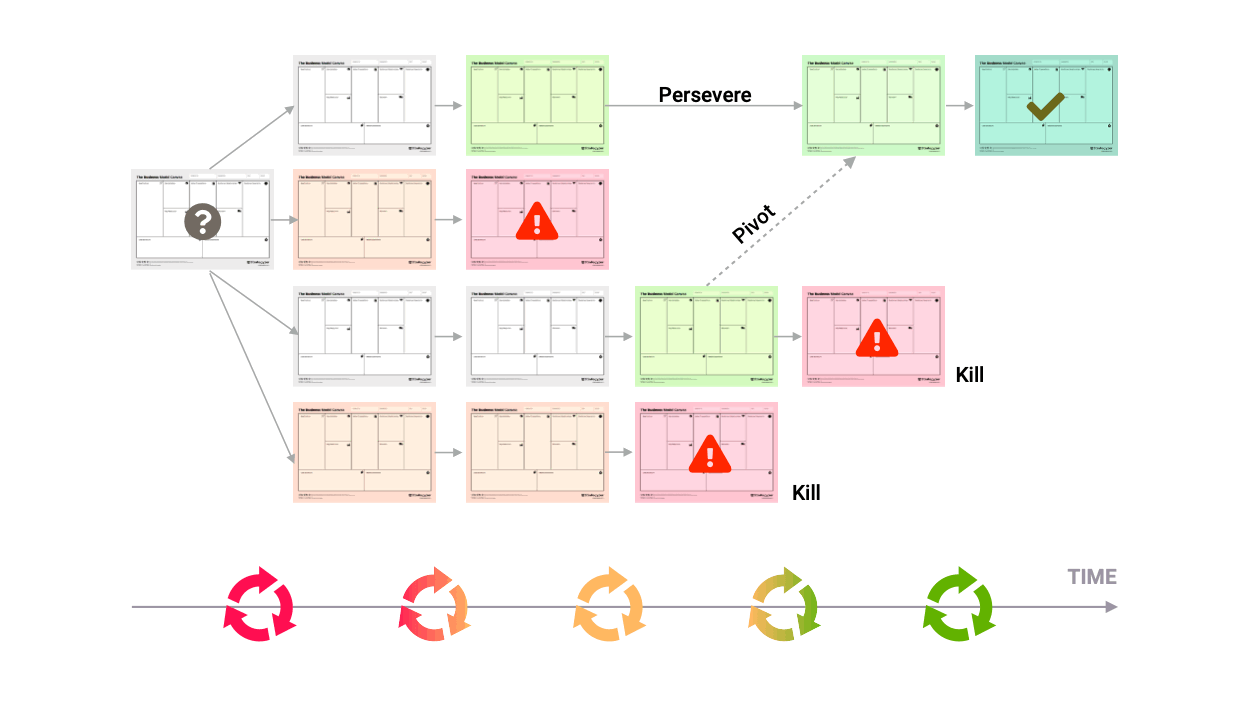Teams operating in Lean Startup mode go through a learning cycle. The experiments built for this purpose (e.g. landing pages, prototypes, etc.) are initially only a means to an end and not yet “the finished product”. The intended outcome is first to transform blind spots into data-driven, actual knowledge.
The validation of business model options over time With multiple passes through the loop and increasing knowledge saturation of the team, a differentiated prototype will develop, commonly called an MVP.
A Lean Startup team will test its critical assumptions in a counter-intuitive order for classic industrial companies: Instead of first building the product, then finding customers and a business model , it will first test whether there are customers; then whether they would pay enough money to make a business worthwhile and only then check whether they are able to build both product and business model. Loosely based on the motto: “When they come – build it!” Corporate startup teams must also ask themselves whether the business opportunities they have discovered fit their company’s strategy and portfolio.
The advantage of this way of working is a parallel minimization of the most important three risks that new product and business model launches always have to face: market risk, business model risk and technology risk.
What this means for industrial companies
Marika Lulay (CEO, GFT) once said so well: “Either industrial companies learn IT or IT companies learn industry.” We say: in addition to all the technological change, the necessity of which even the last straggler should have recognized by now, the agile working methods that have been cultivated in the IT environment over the decades are particularly important. And as mentioned at the beginning, there is still a huge gap there, because many companies are only half-heartedly, if at all, jumping on Scrum and similar “Agile Delivery” approaches for better project management instead of the “Agile Discovery” methodologies that were always running before in parallel . We at co:dify believe that the Lean Startup approach is an important piece of the puzzle for this learning process towards more “Digital Agility” and more effective “Business R&D” in the industry.
Key benefits we see include:
It is a possible way to prevent over-engineering: away from waterfall, towards more customer focus.
The probability of creating products and services that users and customers alike really want is massively increased, especially in the context of the digitization of business models.
The way of working demands and promotes self-responsibility and entrepreneurial action of the employees. In the “old industries”, this is one of the few remaining ways to retain talent with a “digital mindset” and thus retain its sustainable employee base.
It also promotes a data-driven decision-making culture, thus removing opinions, wishful thinking and, above all, power plays and political decisions from product and business model development processes.
In the best case, the latter also ensures that political innovation and zombie projects are recognized and “killed” more quickly, because progress must be measured continuously and iteratively via Innovation Accounting . This frees up previously tied-up resources, which can then be channeled into new innovation projects.
The list could go on and on, but I will leave it at this. We believe that hardly any company can afford to pursue non-agile product development anymore. Whoever does not deal with these approaches now runs the risk of losing more and more competitiveness and future viability. I hope this article has been able to give a first small overview. If you want to learn more details about Lean Startup in general, I recommend the literature list below. If you would like to learn more about Lean Startup in a practical way, I recommend our co:dify learning experiences “Business Design Masterclass” and “Lean Innovation Crash Course” in which we also address the question of how to best adapt the approach to corporate settings . I am always available for inquiries .
The best books on the subject of “Lean Startup
2420821
KVJ4ESL9
1
apa
50
default
6197
https://codify.in/wp-content/plugins/zotpress/
%7B%22status%22%3A%22success%22%2C%22updateneeded%22%3Afalse%2C%22instance%22%3Afalse%2C%22meta%22%3A%7B%22request_last%22%3A0%2C%22request_next%22%3A0%2C%22used_cache%22%3Atrue%7D%2C%22data%22%3A%5B%7B%22key%22%3A%2274MRGLIP%22%2C%22library%22%3A%7B%22id%22%3A2420821%7D%2C%22meta%22%3A%7B%22creatorSummary%22%3A%22Felin%20et%20al.%22%2C%22parsedDate%22%3A%222020-08-01%22%2C%22numChildren%22%3A2%7D%2C%22bib%22%3A%22%3Cdiv%20class%3D%5C%22csl-bib-body%5C%22%20style%3D%5C%22line-height%3A%202%3B%20padding-left%3A%201em%3B%20text-indent%3A-1em%3B%5C%22%3E%5Cn%20%20%3Cdiv%20class%3D%5C%22csl-entry%5C%22%3EFelin%2C%20T.%2C%20Gambardella%2C%20A.%2C%20Stern%2C%20S.%2C%20%26amp%3B%20Zenger%2C%20T.%20%282020%29.%20Lean%20startup%20and%20the%20business%20model%3A%20Experimentation%20revisited.%20%3Ci%3ELong%20Range%20Planning%3C%5C%2Fi%3E%2C%20%3Ci%3E53%3C%5C%2Fi%3E%284%29%2C%20101889.%20%3Ca%20href%3D%27https%3A%5C%2F%5C%2Fdoi.org%5C%2F10.1016%5C%2Fj.lrp.2019.06.002%27%3Ehttps%3A%5C%2F%5C%2Fdoi.org%5C%2F10.1016%5C%2Fj.lrp.2019.06.002%3C%5C%2Fa%3E%3C%5C%2Fdiv%3E%5Cn%3C%5C%2Fdiv%3E%22%2C%22data%22%3A%7B%22itemType%22%3A%22journalArticle%22%2C%22title%22%3A%22Lean%20startup%20and%20the%20business%20model%3A%20Experimentation%20revisited%22%2C%22creators%22%3A%5B%7B%22creatorType%22%3A%22author%22%2C%22firstName%22%3A%22Teppo%22%2C%22lastName%22%3A%22Felin%22%7D%2C%7B%22creatorType%22%3A%22author%22%2C%22firstName%22%3A%22Alfonso%22%2C%22lastName%22%3A%22Gambardella%22%7D%2C%7B%22creatorType%22%3A%22author%22%2C%22firstName%22%3A%22Scott%22%2C%22lastName%22%3A%22Stern%22%7D%2C%7B%22creatorType%22%3A%22author%22%2C%22firstName%22%3A%22Todd%22%2C%22lastName%22%3A%22Zenger%22%7D%5D%2C%22abstractNote%22%3A%22%22%2C%22date%22%3A%22August%201%2C%202020%22%2C%22language%22%3A%22en%22%2C%22DOI%22%3A%2210.1016%5C%2Fj.lrp.2019.06.002%22%2C%22ISSN%22%3A%220024-6301%22%2C%22url%22%3A%22https%3A%5C%2F%5C%2Fwww.sciencedirect.com%5C%2Fscience%5C%2Farticle%5C%2Fpii%5C%2FS0024630119301505%22%2C%22collections%22%3A%5B%22KVJ4ESL9%22%5D%2C%22dateModified%22%3A%222022-02-11T10%3A04%3A02Z%22%7D%7D%2C%7B%22key%22%3A%22JWPEBIWT%22%2C%22library%22%3A%7B%22id%22%3A2420821%7D%2C%22meta%22%3A%7B%22creatorSummary%22%3A%22Cooper%20et%20al.%22%2C%22parsedDate%22%3A%222016%22%2C%22numChildren%22%3A1%7D%2C%22bib%22%3A%22%3Cdiv%20class%3D%5C%22csl-bib-body%5C%22%20style%3D%5C%22line-height%3A%202%3B%20padding-left%3A%201em%3B%20text-indent%3A-1em%3B%5C%22%3E%5Cn%20%20%3Cdiv%20class%3D%5C%22csl-entry%5C%22%3ECooper%2C%20B.%2C%20Vlaskovits%2C%20P.%2C%20%26amp%3B%20Ries%2C%20E.%20%282016%29.%20%3Ci%3EThe%20lean%20entrepreneur%3A%20how%20visionaries%20create%20products%2C%20innovate%20with%20new%20ventures%2C%20and%20disrupt%20markets%3C%5C%2Fi%3E%20%28Second%20edition%29.%20Wiley.%3C%5C%2Fdiv%3E%5Cn%3C%5C%2Fdiv%3E%22%2C%22data%22%3A%7B%22itemType%22%3A%22book%22%2C%22title%22%3A%22The%20lean%20entrepreneur%3A%20how%20visionaries%20create%20products%2C%20innovate%20with%20new%20ventures%2C%20and%20disrupt%20markets%22%2C%22creators%22%3A%5B%7B%22creatorType%22%3A%22author%22%2C%22firstName%22%3A%22Brant%22%2C%22lastName%22%3A%22Cooper%22%7D%2C%7B%22creatorType%22%3A%22author%22%2C%22firstName%22%3A%22Patrick%22%2C%22lastName%22%3A%22Vlaskovits%22%7D%2C%7B%22creatorType%22%3A%22author%22%2C%22firstName%22%3A%22Eric%22%2C%22lastName%22%3A%22Ries%22%7D%5D%2C%22abstractNote%22%3A%22%22%2C%22date%22%3A%222016%22%2C%22language%22%3A%22eng%22%2C%22ISBN%22%3A%22978-1-119-09503-3%22%2C%22url%22%3A%22%22%2C%22collections%22%3A%5B%22QAQ4EBSS%22%2C%22KVJ4ESL9%22%5D%2C%22dateModified%22%3A%222022-01-15T20%3A46%3A33Z%22%7D%7D%2C%7B%22key%22%3A%22RN9HPBGD%22%2C%22library%22%3A%7B%22id%22%3A2420821%7D%2C%22meta%22%3A%7B%22creatorSummary%22%3A%22Savoia%22%2C%22parsedDate%22%3A%222019%22%2C%22numChildren%22%3A1%7D%2C%22bib%22%3A%22%3Cdiv%20class%3D%5C%22csl-bib-body%5C%22%20style%3D%5C%22line-height%3A%202%3B%20padding-left%3A%201em%3B%20text-indent%3A-1em%3B%5C%22%3E%5Cn%20%20%3Cdiv%20class%3D%5C%22csl-entry%5C%22%3ESavoia%2C%20A.%20%282019%29.%20%3Ci%3EThe%20right%20it%3A%20why%20so%20many%20ideas%20fail%20and%20how%20to%20make%20sure%20yours%20succeed%3C%5C%2Fi%3E%20%28First%20edition%29.%20HarperOne.%3C%5C%2Fdiv%3E%5Cn%3C%5C%2Fdiv%3E%22%2C%22data%22%3A%7B%22itemType%22%3A%22book%22%2C%22title%22%3A%22The%20right%20it%3A%20why%20so%20many%20ideas%20fail%20and%20how%20to%20make%20sure%20yours%20succeed%22%2C%22creators%22%3A%5B%7B%22creatorType%22%3A%22author%22%2C%22firstName%22%3A%22Alberto%22%2C%22lastName%22%3A%22Savoia%22%7D%5D%2C%22abstractNote%22%3A%22%5C%22From%20Google%27s%20first%20engineering%20director%20and%20current%20Innovation%20Agitator%20Emeritus%2C%20Alberto%20Savoia%27s%20The%20Right%20It%20is%20built%20around%20a%20simple%20concept--beating%20the%20law%20of%20market%20failure%20when%20launching%20any%20new%20idea%2C%20product%2C%20or%20business%5C%22--%22%2C%22date%22%3A%222019%22%2C%22language%22%3A%22%22%2C%22ISBN%22%3A%22978-0-06-288467-1%22%2C%22url%22%3A%22%22%2C%22collections%22%3A%5B%22QAQ4EBSS%22%2C%22KVJ4ESL9%22%5D%2C%22dateModified%22%3A%222022-01-15T20%3A36%3A08Z%22%7D%7D%2C%7B%22key%22%3A%22MEP73Y6L%22%2C%22library%22%3A%7B%22id%22%3A2420821%7D%2C%22meta%22%3A%7B%22creatorSummary%22%3A%22Kromer%22%2C%22numChildren%22%3A1%7D%2C%22bib%22%3A%22%3Cdiv%20class%3D%5C%22csl-bib-body%5C%22%20style%3D%5C%22line-height%3A%202%3B%20padding-left%3A%201em%3B%20text-indent%3A-1em%3B%5C%22%3E%5Cn%20%20%3Cdiv%20class%3D%5C%22csl-entry%5C%22%3EKromer%2C%20T.%20%28Ed.%29.%20%28n.d.%29.%20%3Ci%3EThe%20Real%20Startup%20Book%3C%5C%2Fi%3E%20%284.0%29.%20self-published.%20Retrieved%20February%203%2C%202020%2C%20from%20%3Ca%20href%3D%27https%3A%5C%2F%5C%2Frealstartupbook.com%5C%2F%27%3Ehttps%3A%5C%2F%5C%2Frealstartupbook.com%5C%2F%3C%5C%2Fa%3E%3C%5C%2Fdiv%3E%5Cn%3C%5C%2Fdiv%3E%22%2C%22data%22%3A%7B%22itemType%22%3A%22book%22%2C%22title%22%3A%22The%20Real%20Startup%20Book%22%2C%22creators%22%3A%5B%7B%22creatorType%22%3A%22editor%22%2C%22firstName%22%3A%22Tristan%22%2C%22lastName%22%3A%22Kromer%22%7D%5D%2C%22abstractNote%22%3A%22%22%2C%22date%22%3A%22%22%2C%22language%22%3A%22%22%2C%22ISBN%22%3A%22%22%2C%22url%22%3A%22https%3A%5C%2F%5C%2Frealstartupbook.com%5C%2F%22%2C%22collections%22%3A%5B%22QAQ4EBSS%22%2C%22KVJ4ESL9%22%5D%2C%22dateModified%22%3A%222020-02-03T17%3A05%3A29Z%22%7D%7D%2C%7B%22key%22%3A%22IKVQ2SZ3%22%2C%22library%22%3A%7B%22id%22%3A2420821%7D%2C%22meta%22%3A%7B%22creatorSummary%22%3A%22Ries%22%2C%22parsedDate%22%3A%222017-10-17%22%2C%22numChildren%22%3A1%7D%2C%22bib%22%3A%22%3Cdiv%20class%3D%5C%22csl-bib-body%5C%22%20style%3D%5C%22line-height%3A%202%3B%20padding-left%3A%201em%3B%20text-indent%3A-1em%3B%5C%22%3E%5Cn%20%20%3Cdiv%20class%3D%5C%22csl-entry%5C%22%3ERies%2C%20E.%20%282017%29.%20%3Ci%3EThe%20Startup%20Way%3A%20How%20Modern%20Companies%20Use%20Entrepreneurial%20Management%20to%20Transform%20Culture%20and%20Drive%20Long-Term%20Growth%3C%5C%2Fi%3E.%20Currency.%3C%5C%2Fdiv%3E%5Cn%3C%5C%2Fdiv%3E%22%2C%22data%22%3A%7B%22itemType%22%3A%22book%22%2C%22title%22%3A%22The%20Startup%20Way%3A%20How%20Modern%20Companies%20Use%20Entrepreneurial%20Management%20to%20Transform%20Culture%20and%20Drive%20Long-Term%20Growth%22%2C%22creators%22%3A%5B%7B%22creatorType%22%3A%22author%22%2C%22firstName%22%3A%22Eric%22%2C%22lastName%22%3A%22Ries%22%7D%5D%2C%22abstractNote%22%3A%22Entrepreneur%20and%20bestselling%20author%20of%5Cu00a0The%20Lean%20Startup%2C%5Cu00a0Eric%20Ries%20reveals%20how%20entrepreneurial%20principles%20can%20be%20used%20by%20businesses%20of%20all%20kinds%2C%20ranging%20from%20established%20companies%20to%20early-stage%20startups%2C%20to%20grow%20revenues%2C%20drive%20innovation%2C%20and%20transform%20themselves%20into%20truly%20modern%20organizations%2C%20poised%20to%20take%20advantage%20of%20the%20enormous%20opportunities%20of%20the%20twenty-first%20century.%5Cu00a0%5Cu00a0%20In%5Cu00a0The%20Lean%20Startup%2C%20Eric%20Ries%20laid%20out%20the%20practices%20of%20successful%20startups%20%5Cu2013%20building%20a%20minimal%20viable%20product%2C%20customer-focused%20and%20scientific%20testing%20based%20on%20a%20build-measure-learn%20method%20of%20continuous%20innovation%2C%20and%20deciding%20whether%20to%20persevere%20or%20pivot.%20In%5Cu00a0The%20Startup%20Way%2C%20he%20turns%20his%20attention%20to%20an%20entirely%20new%20group%20of%20organizations%3A%20established%20enterprises%20like%20iconic%20multinationals%20GE%20and%20Toyota%2C%20tech%20titans%20like%20Amazon%20and%20Facebook%2C%20and%20the%20next%20generation%20of%20Silicon%20Valley%20upstarts%20like%20Airbnb%20and%20Twilio.%20Drawing%20on%20his%20experiences%20over%20the%20past%20five%20years%20working%20with%20these%20organizations%2C%20as%20well%20as%20nonprofits%2C%20NGOs%2C%20and%20governments%2C%5Cu00a0Ries%20lays%20out%20a%20system%20of%20entrepreneurial%20management%20that%20leads%20organizations%20of%20all%20sizes%20%5Cu00a0and%20from%20every%20industry%20to%20sustainable%20growth%20and%20long-term%20impact.%5Cu00a0Filled%20with%20in-the-field%20stories%2C%20insights%2C%20and%20tools%2C%5Cu00a0The%20Startup%20Way%5Cu00a0is%20an%20essential%20road%20map%20for%20any%20organization%20navigating%20the%20uncertain%20waters%20of%20the%20century%20ahead.%22%2C%22date%22%3A%22October%2017%2C%202017%22%2C%22language%22%3A%22English%22%2C%22ISBN%22%3A%22978-1-101-90320-9%22%2C%22url%22%3A%22%22%2C%22collections%22%3A%5B%22QAQ4EBSS%22%2C%22KVJ4ESL9%22%5D%2C%22dateModified%22%3A%222020-02-03T17%3A01%3A35Z%22%7D%7D%2C%7B%22key%22%3A%22MBAZQHI8%22%2C%22library%22%3A%7B%22id%22%3A2420821%7D%2C%22meta%22%3A%7B%22creatorSummary%22%3A%22Bland%20and%20Osterwalder%22%2C%22parsedDate%22%3A%222019-11-12%22%2C%22numChildren%22%3A1%7D%2C%22bib%22%3A%22%3Cdiv%20class%3D%5C%22csl-bib-body%5C%22%20style%3D%5C%22line-height%3A%202%3B%20padding-left%3A%201em%3B%20text-indent%3A-1em%3B%5C%22%3E%5Cn%20%20%3Cdiv%20class%3D%5C%22csl-entry%5C%22%3EBland%2C%20D.%20J.%2C%20%26amp%3B%20Osterwalder%2C%20A.%20%282019%29.%20%3Ci%3ETesting%20Business%20Ideas%3C%5C%2Fi%3E%20%281.%20edition%29.%20Wiley.%3C%5C%2Fdiv%3E%5Cn%3C%5C%2Fdiv%3E%22%2C%22data%22%3A%7B%22itemType%22%3A%22book%22%2C%22title%22%3A%22Testing%20Business%20Ideas%22%2C%22creators%22%3A%5B%7B%22creatorType%22%3A%22author%22%2C%22firstName%22%3A%22David%20J.%22%2C%22lastName%22%3A%22Bland%22%7D%2C%7B%22creatorType%22%3A%22author%22%2C%22firstName%22%3A%22Alexander%22%2C%22lastName%22%3A%22Osterwalder%22%7D%5D%2C%22abstractNote%22%3A%22A%20practical%20guide%20to%20effective%20business%20model%20testing%5Cu00a07%20out%20of%2010%20new%20products%20fail%20to%20deliver%20on%20expectations.%20Testing%20Business%20Ideas%20aims%20to%20reverse%20that%20statistic.%20In%20the%20tradition%20of%20Alex%20Osterwalder%27s%20global%20bestseller%20Business%20Model%20Generation%2C%20this%20practical%20guide%20contains%20a%20library%20of%20hands-on%20techniques%20for%20rapidly%20testing%20new%20business%20ideas.%5Cu00a0Testing%20Business%20Ideas%20explains%20how%20systematically%20testing%20business%20ideas%20dramatically%20reduces%20the%20risk%20and%20increases%20the%20likelihood%20of%20success%20for%20any%20new%20venture%20or%20business%20project.%20It%20builds%20on%20the%20internationally%20popular%20Business%20Model%20Canvas%20and%20Value%20Proposition%20Canvas%20by%20integrating%20Assumptions%20Mapping%20and%20other%20powerful%20lean%20startup-style%20experiments.%5Cu00a0Testing%20Business%20Ideas%20uses%20an%20engaging%204-color%20format%20to%3A%2A%20Increase%20the%20success%20of%20any%20venture%20and%20decrease%20the%20risk%20of%20wasting%20time%2C%20money%2C%20and%20resources%20on%20bad%20ideas%2A%20Close%20the%20knowledge%20gap%20between%20strategy%20and%20experimentation%5C%2Fvalidation%2A%20Identify%20and%20test%20your%20key%20business%20assumptions%20with%20the%20Business%20Model%20Canvas%20and%20Value%20Proposition%20Canvas%5Cu00a0A%20definitive%20field%20guide%20to%20business%20model%20testing%2C%20this%20book%20features%20practical%20tips%20for%20making%20major%20decisions%20that%20are%20not%20based%20on%20intuition%20and%20guesses.%20Testing%20Business%20Ideas%20shows%20leaders%20how%20to%20encourage%20an%20experimentation%20mindset%20within%20their%20organization%20and%20make%20experimentation%20a%20continuous%2C%20repeatable%20process.%22%2C%22date%22%3A%2212%20Nov%202019%22%2C%22language%22%3A%22Englisch%22%2C%22ISBN%22%3A%22978-1-119-55144-7%22%2C%22url%22%3A%22%22%2C%22collections%22%3A%5B%22QAQ4EBSS%22%2C%22KVJ4ESL9%22%5D%2C%22dateModified%22%3A%222020-02-03T16%3A59%3A08Z%22%7D%7D%2C%7B%22key%22%3A%22XHGJQ9GI%22%2C%22library%22%3A%7B%22id%22%3A2420821%7D%2C%22meta%22%3A%7B%22creatorSummary%22%3A%22Blank%22%2C%22parsedDate%22%3A%222013-07-17%22%2C%22numChildren%22%3A1%7D%2C%22bib%22%3A%22%3Cdiv%20class%3D%5C%22csl-bib-body%5C%22%20style%3D%5C%22line-height%3A%202%3B%20padding-left%3A%201em%3B%20text-indent%3A-1em%3B%5C%22%3E%5Cn%20%20%3Cdiv%20class%3D%5C%22csl-entry%5C%22%3EBlank%2C%20S.%20%282013%29.%20%3Ci%3EThe%20Four%20Steps%20to%20the%20Epiphany%3A%20Successful%20Strategies%20for%20Products%20That%20Win%3C%5C%2Fi%3E%20%28005%20edition%29.%20K%26amp%3BS%20RANCH.%3C%5C%2Fdiv%3E%5Cn%3C%5C%2Fdiv%3E%22%2C%22data%22%3A%7B%22itemType%22%3A%22book%22%2C%22title%22%3A%22The%20Four%20Steps%20to%20the%20Epiphany%3A%20Successful%20Strategies%20for%20Products%20That%20Win%22%2C%22creators%22%3A%5B%7B%22creatorType%22%3A%22author%22%2C%22firstName%22%3A%22Steve%22%2C%22lastName%22%3A%22Blank%22%7D%5D%2C%22abstractNote%22%3A%22The%20bestselling%20classic%20that%20launched%2010%2C000%20startups%20and%20new%20corporate%20ventures%20-%20The%20Four%20Steps%20to%20the%20Epiphany%20is%20one%20of%20the%20most%20influential%20and%20practical%20business%20books%20of%20all%20time.%20The%20Four%20Steps%20to%20the%20Epiphany%20launched%20the%20Lean%20Startup%20approach%20to%20new%20ventures.%20It%20was%20the%20first%20book%20to%20offer%20that%20startups%20are%20not%20smaller%20versions%20of%20large%20companies%20and%20that%20new%20ventures%20are%20different%20than%20existing%20ones.Startups%20search%20for%20business%20models%20while%20existing%20companies%20execute%20them.%20The%20book%20offers%20the%20practical%20and%20proven%20four-step%20Customer%20Development%20process%20for%20search%20and%20offers%20insight%20into%20what%20makes%20some%20startups%20successful%20and%20leaves%20others%20selling%20off%20their%20furniture.%20Rather%20than%20blindly%20execute%20a%20plan%2C%20The%20Four%20Steps%20helps%20uncover%20flaws%20in%20product%20and%20business%20plans%20and%20correct%20them%20before%20they%20become%20costly.%20Rapid%20iteration%2C%20customer%20feedback%2C%20testing%20your%20assumptions%20are%20all%20explained%20in%20this%20book.Packed%20with%20concrete%20examples%20of%20what%20to%20do%2C%20how%20to%20do%20it%20and%20when%20to%20do%20it%2C%20the%20book%20will%20leave%20you%20with%20new%20skills%20to%20organize%20sales%2C%20marketing%20and%20your%20business%20for%20success.If%20your%20organization%20is%20starting%20a%20new%20venture%2C%20and%20you%27re%20thinking%20how%20to%20successfully%20organize%20sales%2C%20marketing%20and%20business%20development%20you%20need%20The%20Four%20Steps%20to%20the%20Epiphany.Essential%20reading%20for%20anyone%20starting%20something%20new.%22%2C%22date%22%3A%2217%20July%202013%22%2C%22language%22%3A%22Englisch%22%2C%22ISBN%22%3A%22978-0-9892005-0-9%22%2C%22url%22%3A%22%22%2C%22collections%22%3A%5B%22QAQ4EBSS%22%2C%22KVJ4ESL9%22%5D%2C%22dateModified%22%3A%222020-02-03T16%3A58%3A37Z%22%7D%7D%2C%7B%22key%22%3A%2277ZYB5SZ%22%2C%22library%22%3A%7B%22id%22%3A2420821%7D%2C%22meta%22%3A%7B%22creatorSummary%22%3A%22Blank%22%2C%22parsedDate%22%3A%222013-05-01%22%2C%22numChildren%22%3A1%7D%2C%22bib%22%3A%22%3Cdiv%20class%3D%5C%22csl-bib-body%5C%22%20style%3D%5C%22line-height%3A%202%3B%20padding-left%3A%201em%3B%20text-indent%3A-1em%3B%5C%22%3E%5Cn%20%20%3Cdiv%20class%3D%5C%22csl-entry%5C%22%3EBlank%2C%20S.%20%282013%2C%20May%201%29.%20Why%20the%20Lean%20Start-Up%20Changes%20Everything.%20%3Ci%3EHarvard%20Business%20Review%3C%5C%2Fi%3E%2C%20%3Ci%3EMay%202013%3C%5C%2Fi%3E.%20%3Ca%20href%3D%27https%3A%5C%2F%5C%2Fhbr.org%5C%2F2013%5C%2F05%5C%2Fwhy-the-lean-start-up-changes-everything%27%3Ehttps%3A%5C%2F%5C%2Fhbr.org%5C%2F2013%5C%2F05%5C%2Fwhy-the-lean-start-up-changes-everything%3C%5C%2Fa%3E%3C%5C%2Fdiv%3E%5Cn%3C%5C%2Fdiv%3E%22%2C%22data%22%3A%7B%22itemType%22%3A%22magazineArticle%22%2C%22title%22%3A%22Why%20the%20Lean%20Start-Up%20Changes%20Everything%22%2C%22creators%22%3A%5B%7B%22creatorType%22%3A%22author%22%2C%22firstName%22%3A%22Steve%22%2C%22lastName%22%3A%22Blank%22%7D%5D%2C%22abstractNote%22%3A%22Launching%20a%20new%20enterprise%5Cu2014whether%20it%5Cu2019s%20a%20tech%20start-up%2C%20a%20small%20business%2C%20or%20an%20initiative%20within%20a%20large%20corporation%5Cu2014has%20always%20been%20a%20hit-or-miss%20proposition.%20According%20to%20the%20decades-old%20formula%2C%20you%20write%20a%20business%20plan%2C%20pitch%20it%20to%20investors%2C%20assemble%20a%20team%2C%20introduce%20a%20product%2C%20and%20start%20selling%20as%20hard%20as%20you%20can.%20And%20somewhere%20in%20this%20%5B%5Cu2026%5D%22%2C%22date%22%3A%222013-05-01T04%3A00%3A00Z%22%2C%22language%22%3A%22%22%2C%22ISSN%22%3A%220017-8012%22%2C%22url%22%3A%22https%3A%5C%2F%5C%2Fhbr.org%5C%2F2013%5C%2F05%5C%2Fwhy-the-lean-start-up-changes-everything%22%2C%22collections%22%3A%5B%22QAQ4EBSS%22%2C%22KVJ4ESL9%22%5D%2C%22dateModified%22%3A%222020-02-03T16%3A58%3A11Z%22%7D%7D%2C%7B%22key%22%3A%22PS53RJ8V%22%2C%22library%22%3A%7B%22id%22%3A2420821%7D%2C%22meta%22%3A%7B%22creatorSummary%22%3A%22Osterwalder%20et%20al.%22%2C%22parsedDate%22%3A%222014-10-20%22%2C%22numChildren%22%3A1%7D%2C%22bib%22%3A%22%3Cdiv%20class%3D%5C%22csl-bib-body%5C%22%20style%3D%5C%22line-height%3A%202%3B%20padding-left%3A%201em%3B%20text-indent%3A-1em%3B%5C%22%3E%5Cn%20%20%3Cdiv%20class%3D%5C%22csl-entry%5C%22%3EOsterwalder%2C%20A.%2C%20Pigneur%2C%20Y.%2C%20Bernarda%2C%20G.%2C%20Smith%2C%20A.%2C%20%26amp%3B%20Papadakos%2C%20T.%20%282014%29.%20%3Ci%3EValue%20Proposition%20Design%3A%20How%20to%20Create%20Products%20and%20Services%20Customers%20Want%3C%5C%2Fi%3E%20%281%20edition%29.%20Wiley.%3C%5C%2Fdiv%3E%5Cn%3C%5C%2Fdiv%3E%22%2C%22data%22%3A%7B%22itemType%22%3A%22book%22%2C%22title%22%3A%22Value%20Proposition%20Design%3A%20How%20to%20Create%20Products%20and%20Services%20Customers%20Want%22%2C%22creators%22%3A%5B%7B%22creatorType%22%3A%22author%22%2C%22firstName%22%3A%22Alexander%22%2C%22lastName%22%3A%22Osterwalder%22%7D%2C%7B%22creatorType%22%3A%22author%22%2C%22firstName%22%3A%22Yves%22%2C%22lastName%22%3A%22Pigneur%22%7D%2C%7B%22creatorType%22%3A%22author%22%2C%22firstName%22%3A%22Gregory%22%2C%22lastName%22%3A%22Bernarda%22%7D%2C%7B%22creatorType%22%3A%22author%22%2C%22firstName%22%3A%22Alan%22%2C%22lastName%22%3A%22Smith%22%7D%2C%7B%22creatorType%22%3A%22author%22%2C%22firstName%22%3A%22Trish%22%2C%22lastName%22%3A%22Papadakos%22%7D%5D%2C%22abstractNote%22%3A%22The%20authors%20of%20the%20international%20bestseller%20Business%20Model%20Generation%20explain%20how%20to%20create%20value%20propositions%20customers%20can%5Cu2019t%20resist%20Value%20Proposition%20Design%20helps%20you%20tackle%20the%20core%20challenge%20of%20every%20business%20%5Cu2014%20creating%20compelling%20products%20and%20services%20customers%20want%20to%20buy.%20This%20highly%20practical%20book%2C%20paired%20with%20its%20online%20companion%2C%20will%20teach%20you%20the%20processes%20and%20tools%20you%20need%20to%20create%20products%20that%20sell.Using%20the%20same%20stunning%20visual%20format%20as%20the%20authors%5Cu2019%20global%20bestseller%2C%20Business%20Model%20Generation%2C%20this%20sequel%20explains%20how%20to%20use%20the%20%5Cu201cValue%20Proposition%20Canvas%5Cu201d%20to%20design%2C%20test%2C%20create%2C%20and%20manage%20products%20and%20services%20customers%20actually%20want.Value%20Proposition%20Design%20is%20for%20anyone%20who%20has%20been%20frustrated%20by%20new%20product%20meetings%20based%20on%20hunches%20and%20intuitions%3B%20it%5Cu2019s%20for%20anyone%20who%20has%20watched%20an%20expensive%20new%20product%20launch%20fail%20in%20the%20market.%20The%20book%20will%20help%20you%20understand%20the%20patterns%20of%20great%20value%20propositions%2C%20get%20closer%20to%20customers%2C%20and%20avoid%20wasting%20time%20with%20ideas%20that%20won%5Cu2019t%20work.%20You%5Cu2019ll%20learn%20the%20simple%20process%20of%20designing%20and%20testing%20value%20propositions%2C%20that%20perfectly%20match%20customers%5Cu2019%20needs%20and%20desires.In%20addition%20the%20book%20gives%20you%20exclusive%20access%20to%20an%20online%20companion%20on%20Strategyzer.com.%20You%20will%20be%20able%20to%20assess%20your%20work%2C%20learn%20from%20peers%2C%20and%20download%20pdfs%2C%20checklists%2C%20and%20more.Value%20Proposition%20Design%20is%20an%20essential%20companion%20to%20the%20%5Cu201dBusiness%20Model%20Canvas%5Cu201d%20from%20Business%20Model%20Generation%2C%20a%20tool%20embraced%20globally%20by%20startups%20and%20large%20corporations%20such%20as%20MasterCard%2C%203M%2C%20Coca%20Cola%2C%20GE%2C%20Fujitsu%2C%20LEGO%2C%20Colgate-Palmolive%2C%20and%20many%20more.Value%20Proposition%20Design%20gives%20you%20a%20proven%20methodology%20for%20success%2C%20with%20value%20propositions%20that%20sell%2C%20embedded%20in%20profitable%20business%20models.%5C%22%22%2C%22date%22%3A%22October%2020%2C%202014%22%2C%22language%22%3A%22English%22%2C%22ISBN%22%3A%22978-1-118-96805-5%22%2C%22url%22%3A%22%22%2C%22collections%22%3A%5B%22QAQ4EBSS%22%2C%22KVJ4ESL9%22%5D%2C%22dateModified%22%3A%222020-02-03T16%3A56%3A56Z%22%7D%7D%2C%7B%22key%22%3A%22PL8XLCET%22%2C%22library%22%3A%7B%22id%22%3A2420821%7D%2C%22meta%22%3A%7B%22creatorSummary%22%3A%22Ries%22%2C%22parsedDate%22%3A%222001-01-01%22%2C%22numChildren%22%3A1%7D%2C%22bib%22%3A%22%3Cdiv%20class%3D%5C%22csl-bib-body%5C%22%20style%3D%5C%22line-height%3A%202%3B%20padding-left%3A%201em%3B%20text-indent%3A-1em%3B%5C%22%3E%5Cn%20%20%3Cdiv%20class%3D%5C%22csl-entry%5C%22%3ERies%2C%20E.%20%282001%29.%20%3Ci%3EThe%20Lean%20Startup%3A%20How%20Today%26%23x2019%3Bs%20Entrepreneurs%20Use%20Continuous%20Innovation%20to%20Create%20Radically%20Successful%20Businesses%3C%5C%2Fi%3E.%20Viking.%3C%5C%2Fdiv%3E%5Cn%3C%5C%2Fdiv%3E%22%2C%22data%22%3A%7B%22itemType%22%3A%22book%22%2C%22title%22%3A%22The%20Lean%20Startup%3A%20How%20Today%27s%20Entrepreneurs%20Use%20Continuous%20Innovation%20to%20Create%20Radically%20Successful%20Businesses%22%2C%22creators%22%3A%5B%7B%22creatorType%22%3A%22author%22%2C%22firstName%22%3A%22Eric%22%2C%22lastName%22%3A%22Ries%22%7D%5D%2C%22abstractNote%22%3A%22lean%20startup%2C%20the%22%2C%22date%22%3A%22January%201%2C%202001%22%2C%22language%22%3A%22English%22%2C%22ISBN%22%3A%22978-0-670-92160-7%22%2C%22url%22%3A%22%22%2C%22collections%22%3A%5B%22QAQ4EBSS%22%2C%22KVJ4ESL9%22%5D%2C%22dateModified%22%3A%222020-02-03T16%3A56%3A56Z%22%7D%7D%2C%7B%22key%22%3A%22V935SNZW%22%2C%22library%22%3A%7B%22id%22%3A2420821%7D%2C%22meta%22%3A%7B%22creatorSummary%22%3A%22Osterwalder%20and%20Pigneur%22%2C%22parsedDate%22%3A%222009-09%22%2C%22numChildren%22%3A1%7D%2C%22bib%22%3A%22%3Cdiv%20class%3D%5C%22csl-bib-body%5C%22%20style%3D%5C%22line-height%3A%202%3B%20padding-left%3A%201em%3B%20text-indent%3A-1em%3B%5C%22%3E%5Cn%20%20%3Cdiv%20class%3D%5C%22csl-entry%5C%22%3EOsterwalder%2C%20A.%2C%20%26amp%3B%20Pigneur%2C%20Y.%20%282009%29.%20%3Ci%3EBusiness%20Model%20Generation%20-%20A%20Handbook%20for%20Visionaries%2C%20Game%20Changers%20%26amp%3B%20Challengers%3C%5C%2Fi%3E.%20Self%20Published.%3C%5C%2Fdiv%3E%5Cn%3C%5C%2Fdiv%3E%22%2C%22data%22%3A%7B%22itemType%22%3A%22book%22%2C%22title%22%3A%22Business%20Model%20Generation%20-%20A%20Handbook%20for%20Visionaries%2C%20Game%20Changers%20%26%20Challengers%22%2C%22creators%22%3A%5B%7B%22creatorType%22%3A%22author%22%2C%22firstName%22%3A%22Alexander%22%2C%22lastName%22%3A%22Osterwalder%22%7D%2C%7B%22creatorType%22%3A%22author%22%2C%22firstName%22%3A%22Yves%22%2C%22lastName%22%3A%22Pigneur%22%7D%5D%2C%22abstractNote%22%3A%22%22%2C%22date%22%3A%22September%202009%22%2C%22language%22%3A%22%22%2C%22ISBN%22%3A%22%22%2C%22url%22%3A%22%22%2C%22collections%22%3A%5B%22QAQ4EBSS%22%2C%22KVJ4ESL9%22%5D%2C%22dateModified%22%3A%222020-02-03T16%3A56%3A56Z%22%7D%7D%2C%7B%22key%22%3A%22TK4T2LXC%22%2C%22library%22%3A%7B%22id%22%3A2420821%7D%2C%22meta%22%3A%7B%22creatorSummary%22%3A%22Blank%20and%20Dorf%22%2C%22parsedDate%22%3A%222012-03-01%22%2C%22numChildren%22%3A1%7D%2C%22bib%22%3A%22%3Cdiv%20class%3D%5C%22csl-bib-body%5C%22%20style%3D%5C%22line-height%3A%202%3B%20padding-left%3A%201em%3B%20text-indent%3A-1em%3B%5C%22%3E%5Cn%20%20%3Cdiv%20class%3D%5C%22csl-entry%5C%22%3EBlank%2C%20S.%2C%20%26amp%3B%20Dorf%2C%20B.%20%282012%29.%20%3Ci%3EThe%20Startup%20Owner%26%23x2019%3Bs%20Manual%3A%20The%20Step-By-Step%20Guide%20for%20Building%20a%20Great%20Company%3C%5C%2Fi%3E%20%281%20edition%29.%20K%20%26amp%3B%20S%20Ranch.%3C%5C%2Fdiv%3E%5Cn%3C%5C%2Fdiv%3E%22%2C%22data%22%3A%7B%22itemType%22%3A%22book%22%2C%22title%22%3A%22The%20Startup%20Owner%27s%20Manual%3A%20The%20Step-By-Step%20Guide%20for%20Building%20a%20Great%20Company%22%2C%22creators%22%3A%5B%7B%22creatorType%22%3A%22author%22%2C%22firstName%22%3A%22Steve%22%2C%22lastName%22%3A%22Blank%22%7D%2C%7B%22creatorType%22%3A%22author%22%2C%22firstName%22%3A%22Bob%22%2C%22lastName%22%3A%22Dorf%22%7D%5D%2C%22abstractNote%22%3A%22More%20than%20100%2C000%20entrepreneurs%20rely%20on%20this%20book%20for%20detailed%2C%20step-by-step%20instructions%20on%20building%20successful%2C%20scalable%2C%20profitable%20startups.%5Cu00a0%20The%20National%20Science%20Foundation%20pays%20hundreds%20of%20startup%20teams%20each%20year%20to%20follow%20the%20process%20outlined%20in%20the%20book%2C%20and%20it%27s%20taught%20at%20Stanford%2C%20Berkeley%2C%20Columbia%20and%20more%20than%20100%20other%20leading%20universities%20worldwide.%5Cu00a0%20Why%3FThe%20Startup%20Owner%27s%20Manual%20guides%20you%2C%20step-by-step%2C%20as%20you%20put%20the%20Customer%20Development%20process%20to%20work.%20This%20method%20was%20created%20by%20renowned%20Silicon%20Valley%20startup%20expert%20Steve%20Blank%2C%20acknowledged%20catalyst%20of%20the%20%5C%22Lean%20Startup%5C%22%20movement%2C%20and%20tested%20and%20refined%20by%20him%20for%20more%20than%20a%20decade.%5Cu00a0This%20608-page%20how-to%20guide%20includes%20over%20100%20charts%2C%20graphs%2C%20and%20diagrams%2C%20plus%2077%20valuable%20checklists%20that%20guide%20you%20as%20you%20drive%20your%20company%20toward%20profitability.%5Cu00a0%20It%20will%20help%20you%3A%5Cu00b7%5Cu00a0%5Cu00a0%5Cu00a0%5Cu00a0%5Cu00a0%5Cu00a0%5Cu00a0%5Cu00a0Avoid%20the%209%20deadly%20sins%20that%20destroy%20startups%27%20chances%20for%20success%5Cu00b7%5Cu00a0%5Cu00a0%5Cu00a0%5Cu00a0%5Cu00a0%5Cu00a0%5Cu00a0Use%20the%20Customer%20Development%20method%20to%20bring%20your%20business%20idea%20to%20life%5Cu00b7%5Cu00a0%5Cu00a0%5Cu00a0%5Cu00a0%5Cu00a0%5Cu00a0%5Cu00a0Incorporate%20the%20Business%20Model%20Canvas%20as%20the%20organizing%20principle%20for%20startup%20hypotheses%5Cu00b7%5Cu00a0%5Cu00a0%5Cu00a0%5Cu00a0%5Cu00a0%5Cu00a0%5Cu00a0Identify%20your%20customers%20and%20determine%20how%20to%20%5C%22get%2C%20keep%20and%20grow%5C%22%20customers%20profitably%5Cu00b7%5Cu00a0%5Cu00a0%5Cu00a0%5Cu00a0%5Cu00a0%5Cu00a0%5Cu00a0Compute%20how%20you%27ll%20drive%20your%20startup%20to%20repeatable%2C%20scalable%20profits.%22%2C%22date%22%3A%22March%201%2C%202012%22%2C%22language%22%3A%22English%22%2C%22ISBN%22%3A%22978-0-9849993-0-9%22%2C%22url%22%3A%22%22%2C%22collections%22%3A%5B%22QAQ4EBSS%22%2C%22KVJ4ESL9%22%5D%2C%22dateModified%22%3A%222020-02-03T16%3A56%3A56Z%22%7D%7D%2C%7B%22key%22%3A%22A2Z967NA%22%2C%22library%22%3A%7B%22id%22%3A2420821%7D%2C%22meta%22%3A%7B%22creatorSummary%22%3A%22Maurya%22%2C%22parsedDate%22%3A%222012%22%2C%22numChildren%22%3A1%7D%2C%22bib%22%3A%22%3Cdiv%20class%3D%5C%22csl-bib-body%5C%22%20style%3D%5C%22line-height%3A%202%3B%20padding-left%3A%201em%3B%20text-indent%3A-1em%3B%5C%22%3E%5Cn%20%20%3Cdiv%20class%3D%5C%22csl-entry%5C%22%3EMaurya%2C%20A.%20%282012%29.%20%3Ci%3ERunning%20Lean%3A%20Iterate%20from%20Plan%20A%20to%20a%20Plan%20That%20Works%3C%5C%2Fi%3E%20%282nd%20ed.%29.%20O%26%23x2019%3BReilly%20and%20Associates.%3C%5C%2Fdiv%3E%5Cn%3C%5C%2Fdiv%3E%22%2C%22data%22%3A%7B%22itemType%22%3A%22book%22%2C%22title%22%3A%22Running%20Lean%3A%20Iterate%20from%20Plan%20A%20to%20a%20Plan%20That%20Works%22%2C%22creators%22%3A%5B%7B%22creatorType%22%3A%22author%22%2C%22firstName%22%3A%22Ash%22%2C%22lastName%22%3A%22Maurya%22%7D%5D%2C%22abstractNote%22%3A%22We%20live%20in%20an%20age%20of%20unparalleled%20opportunity%20for%20innovation.%20We%5Cu2019re%20building%20more%20products%20than%20ever%20before%2C%20but%20most%20of%20them%20fail%5Cu2015not%20because%20we%20can%5Cu2019t%20complete%20what%20we%20set%20out%20to%20build%2C%20but%20because%20we%20waste%20time%2C%20money%2C%20and%20effort%20building%20the%20wrong%20product.What%20we%20need%20is%20a%20systematic%20process%20for%20quickly%20vetting%20product%20ideas%20and%20raising%20our%20odds%20of%20success.%20That%5Cu2019s%20the%20promise%20of%20Running%20Lean.In%20this%20inspiring%20book%2C%20Ash%20Maurya%20takes%20you%20through%20an%20exacting%20strategy%20for%20achieving%20a%20%5C%22product%5C%2Fmarket%20fit%5C%22%20for%20your%20fledgling%20venture%2C%20based%20on%20his%20own%20experience%20in%20building%20a%20wide%20array%20of%20products%20from%20high-tech%20to%20no-tech.%20Throughout%2C%20he%20builds%20on%20the%20ideas%20and%20concepts%20of%20several%20innovative%20methodologies%2C%20including%20the%20Lean%20Startup%2C%20Customer%20Development%2C%20and%20bootstrapping.Running%20Lean%20is%20an%20ideal%20tool%20for%20business%20managers%2C%20CEOs%2C%20small%20business%20owners%2C%20developers%20and%20programmers%2C%20and%20anyone%20who%5Cu2019s%20interested%20in%20starting%20a%20business%20project.%2A%20Find%20a%20problem%20worth%20solving%2C%20then%20define%20a%20solution%2A%20Engage%20your%20customers%20throughout%20the%20development%20cycle%2A%20Continually%20test%20your%20product%20with%20smaller%2C%20faster%20iterations%2A%20Build%20a%20feature%2C%20measure%20customer%20response%2C%20and%20verify%5C%2Frefute%20the%20idea%2A%20Know%20when%20to%20%5C%22pivot%5C%22%20by%20changing%20your%20plan%5Cu2019s%20course%2A%20Maximize%20your%20efforts%20for%20speed%2C%20learning%2C%20and%20focus%2A%20Learn%20the%20ideal%20time%20to%20raise%20your%20%5C%22big%20round%5C%22%20of%20fundingGet%20on%20track%20with%20The%20Lean%20SeriesPresented%20by%20Eric%20Ries%5Cu2015bestselling%20author%20of%20The%20Lean%20Startup%3A%20How%20Today%5Cu2019s%20Entrepreneurs%20Use%20Continuous%20Innovation%20to%20Create%20Radically%20Successful%20Businesses%5Cu2015The%20Lean%20Series%20gives%20you%20solid%20footing%20in%20a%20proven%20methodology%20that%20will%20help%20your%20business%20succeed.%22%2C%22date%22%3A%2227.%20M%5Cu00e4rz%202012%22%2C%22language%22%3A%22Englisch%22%2C%22ISBN%22%3A%22978-1-4493-0517-8%22%2C%22url%22%3A%22%22%2C%22collections%22%3A%5B%22QAQ4EBSS%22%2C%22KVJ4ESL9%22%5D%2C%22dateModified%22%3A%222020-02-03T16%3A56%3A17Z%22%7D%7D%5D%7D
Felin, T., Gambardella, A., Stern, S., & Zenger, T. (2020). Lean startup and the business model: Experimentation revisited.
Long Range Planning ,
53 (4), 101889.
https://doi.org/10.1016/j.lrp.2019.06.002
Cooper, B., Vlaskovits, P., & Ries, E. (2016). The lean entrepreneur: how visionaries create products, innovate with new ventures, and disrupt markets (Second edition). Wiley.
Savoia, A. (2019). The right it: why so many ideas fail and how to make sure yours succeed (First edition). HarperOne.
Kromer, T. (Ed.). (n.d.).
The Real Startup Book (4.0). self-published. Retrieved February 3, 2020, from
https://realstartupbook.com/
Ries, E. (2017). The Startup Way: How Modern Companies Use Entrepreneurial Management to Transform Culture and Drive Long-Term Growth . Currency.
Bland, D. J., & Osterwalder, A. (2019). Testing Business Ideas (1. edition). Wiley.
Blank, S. (2013). The Four Steps to the Epiphany: Successful Strategies for Products That Win (005 edition). K&S RANCH.
Blank, S. (2013, May 1). Why the Lean Start-Up Changes Everything.
Harvard Business Review ,
May 2013 .
https://hbr.org/2013/05/why-the-lean-start-up-changes-everything
Osterwalder, A., Pigneur, Y., Bernarda, G., Smith, A., & Papadakos, T. (2014). Value Proposition Design: How to Create Products and Services Customers Want (1 edition). Wiley.
Ries, E. (2001). The Lean Startup: How Today’s Entrepreneurs Use Continuous Innovation to Create Radically Successful Businesses . Viking.
Osterwalder, A., & Pigneur, Y. (2009). Business Model Generation - A Handbook for Visionaries, Game Changers & Challengers . Self Published.
Blank, S., & Dorf, B. (2012). The Startup Owner’s Manual: The Step-By-Step Guide for Building a Great Company (1 edition). K & S Ranch.
Maurya, A. (2012). Running Lean: Iterate from Plan A to a Plan That Works (2nd ed.). O’Reilly and Associates.

